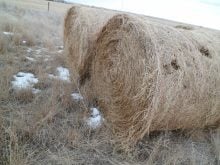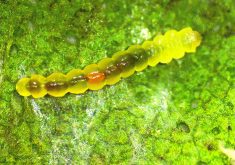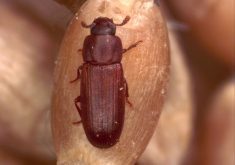Producers are urged to watch their canola fields closely but not to be too afraid of some feeding, which is necessary
Flea beetles account for more than $250 million annually in crop damage on the Prairies, despite farmers’ best efforts to control them.
And with the mild winter and warm spring, farmers might want to be extra vigilant.
Scott Hartley, Saskatchewan Agriculture entomologist, said he is not surprised to see beetle movement already because last year had high populations.
“They overwinter as adults, so with a good mild spring like what we’ve had, mild, dry, it would be favourable for them.”
Flea beetle adults and larvae feed on canola. Damage is most prevalent during the initial three weeks after emergence. The delicate cotyledons are prime vegetation for the insects.
Read Also

Why feds imposed EV tariffs
Moe and Kinew have a fight on their hands when it comes to eliminating the EV tariff. Canada has to worry about pissing off the U.S. and Mexico and hundreds of thousands of auto workers.
Once the crop reaches the three to four leaf stage, it can withstand the damage.
“The seed treatments on the majority of the seeds, on all the hybrids, should be a good protectant,” said Hartley.
Seed treatments provide three to four weeks of protection for canola that appear within a week of seeding.
Since 2001, neonicotinoid insecticides have been present in all seed treatments registered for flea beetle control in Canada.
Hartley recommends farmers start scouting their fields early.
“Start watching for feeding because with the neonics, (flea beetles) have to feed on the plant tissue in order to ingest some of the seed treatment and therefore that’s what results in the death, but they still have to feed in the first place,” he said.
Keith Gabert, an agrology specialist for the Canola Council of Canada, said canola can withstand a lot of insect damage without a significant yield impact, if it has good growing conditions and adequate soil moisture to bounce back.
“Only when adult populations are extreme, and when dry conditions are hindering the crop from compensating for the damage, is a spray recommended,” he said.
He also recommends scouting canola every two days, especially in the first few weeks when the crop is in emergence stages.
“A diligent job of scouting, in numerous places in the field, is required because we see across the Prairies often a lot of edge effect, so the first 10 to 20 steps in the field may be worse than the rest of the field,” said Gabert.
He said some farmers might spray for insurance against flea beetles, but he advises it’s not always necessary.
“Preferably, go back in a day or two just before you make that decision that you need to spray and check if you really do need to.”
Foliar sprays are pricey so before buying, look for 25 percent defoliation in the field, he said.
He added that farmers will see some damage because beetles have to ingest the treated seed for the insecticide to work.
Farmers should check that damage is at the 25 percent damage threshold.
If the crop is sprayed before damage reaches that threshold, it can increase the risk of flea beetles developing resistance to the insecticide.
With neonicotinoid treatments drawing public attention and added government regulations due to reports these may be harmful to bees, as well as increased public scrutiny of most spray chemicals, Harley recommends farmers use a variety of control measures.
Integrated pest management (IPM) techniques can help cut costs and provide an alternative to pesticides alone.
“IPM is using economic thresholds if you are going to consider using chemical spray, but it’s also using non-chemical controls and other strategies,” said Hartley.
The best IPM techniques are using biological control agents if possible, diversifying crops, proper rotations, inter-row planting, timing of seeding, using less sensitive crop species in infected areas and using trap crops.
Hartley advises that zero tolerance is not realistic and IPM practices don’t always work, but in most situations seed treatment remains a solid management choice.
Contact tennessa.wild@producer.com















